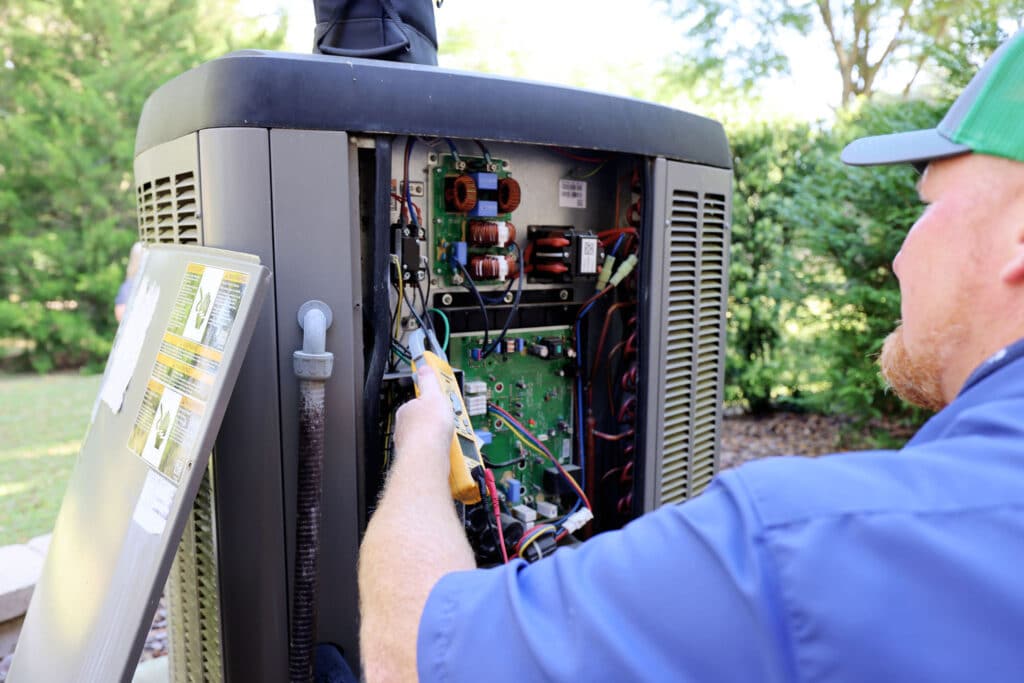Have you ever tried to express something to your doctor but didn’t have the right words to describe where the pain or issue was? This experience is frustrating, overwhelming, and can leave you feeling helpless. Talking to your HVAC technician does not have to feel this way!
At Comfort Temp, we strive to do right by you and want you to feel well-prepared when communicating what’s aggravating your air conditioning system. Having a working knowledge of some of the most frequently used air conditioning terms and a general idea of the air conditioning process can help you feel more comfortable getting help when your HVAC unit needs it.
It’s important to note that this blog does not aim to inform users how to fix their own air conditioning units. We recommend calling in a professional if your AC unit is showing any warning signs of a falling unit.
What’s Inside an Air Conditioning Unit?
Start by getting to know the main parts that make up your air conditioning unit.
- Refrigerant: Refrigerant, or freon, is a chemical that cools while evaporating. This is especially powerful because it can evaporate at a low temperature.
- Compressor: A compressor can be thought of as the engine of an AC unit. The compressor is responsible for converting refrigerant from a cool liquid to a gas and back again.
- Condenser Coil: The condenser coil removes heat from the refrigerant. Refrigerant enters the condenser oil after it is vaporized in the compressor.
- Evaporator Coil: The evaporator coil absorbs the heat from inside your house. It works with the condenser coil to form a looping process.
How the Air Conditioning Process Works
In North Central Florida, we all know all too well what a house with a broken AC unit feels like—hot, humid, and simply uncomfortable. But how does a working air conditioning unit function? The process can be broken into the “cold side” and “hot side” of the system.
The “Cold Side” of the AC System
This is the part of the AC process that occurs inside of your home. The heat from inside your house is blown across a cooling coil full of liquid refrigerant. This traps, or absorbs, the heat in the liquid.
The process is handed off to the “hot side” as the refrigerant heats up. The cooled air is later blown back into your house, keeping your space comfortable in the Florida heat.
The “Hot Side” of the AC System
This part of the air conditioning process occurs outside of your home. The compressor “squeezes” the refrigerant gas, further raising its temperature. It works with the condenser to turn refrigerant gas back into a liquid. A fan blows the heat off the liquid and cools. This sends the liquid back into the house to evaporate again and release heat outside.
Overview of the AC Process
Evaporation is the basic idea behind the air conditioning process—when a liquid evaporates, it feels cool. The result of both sides of the system is a continuous cycle of removing heat from indoors and returning cool air into your home.
Central Air Conditioners
The most common type of air conditioning, especially in Florida, is central air conditioners. Most likely, this is the type of air conditioning that cools your home. Central air conditioning simply means that your AC can cool your entire home, not just one or two rooms at a time. There are two types of central air conditioners: split systems and packaged units.
Split Systems
These systems are ideal for families with larger spaces or businesses because they have both an indoor and an outdoor unit with copper tubing. They are more efficient than other options and highly customizable given their two-part structure. Split systems have high energy efficiency and may add value to your home’s worth. You’d know if you have a split system if you can see physical units inside your home, usually mounted high on your walls.
Packaged Units
When looking for a convenient solution for limited space in a home or business, a package system is your best option. As the name implies, packaged units comprise all the necessary features in a singular unit located outside your home. Compared to window air conditioners, these units have much higher cooling and heating capacity. A packaged unit includes a fan, condenser coil, compressor, and fan coil in one unit. You’d know if you had a packaged unit if you have a large HVAC unit outside and then just vents inside your home.
Features & Benefits of Central Air
There are several benefits you can enjoy from central air conditioning. Some of these benefits include:
- The ability to preset your thermostat to turn down if temperatures rise.
- Significantly more economical than window or wall units.
- Improved indoor air quality through advanced filtration.
- Lower humidity levels throughout your home.
- Both quieter and takes less space than other AC systems.
Comfort Temp Ensures Your Air Conditioning Works
Now that you’ve gotten an overview of the parts of an AC system and how it works, you’re well prepared to call in a professional for a checkup. We even offer 24/7 emergency support, so you’re never uncomfortable for long. We want to make sure you have everything you need to have peace of mind throughout the entire inspection, repair, or replacement process!


